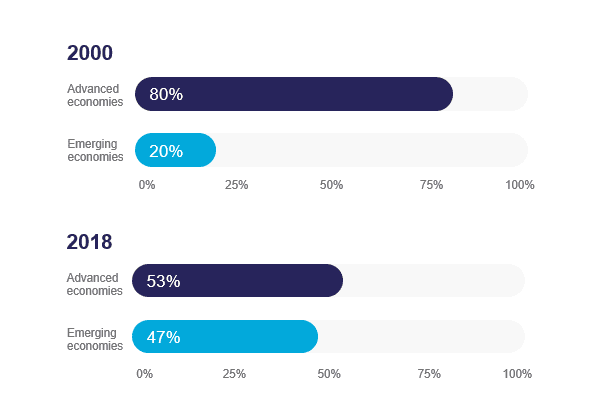Our client, a leading air traffic control agency, was on a journey to improve the maturity of their portfolio and program management practices. With greater capability, the client would be able to better deliver against a portfolio of initiatives including both major capital investments and large business transformation programs. MIGSO-PCUBED was engaged to support the deployment of an improved business change framework, enabling enhanced communication, improved engagement, and increased delivery success for the client organization.
Air traffic control agencies have a significant portfolio of change programs in flight at any given time. This requires a strong Project Management framework to ensure the on time delivery of their change programs.
Air traffic continues to rise, with emerging markets showing the greatest growth over the last decade as per the 2019 ACI World Traffic Report.

This continued increase in traffic requires a focus on the modernization of existing infrastructure and the introduction of next generation technology that supports more efficient airspace management and increases take-offs and landings. This means more scope.
Our client needed the ability to manage all that business change within a single portfolio and to keep it on track. As the client’s existing framework covered their business change process from end to end, it became too complex to manage. They needed direction on how to improve their current PM framework to better meet future demands.
MIGSO-PCUBED was engaged to support the integration of a complex business change framework improvement project. The project aimed to cover all aspects of strategic portfolio management and change delivery, while also incorporating AXELOS best practice guidance.
AXELOS, created in 2013, is responsible for a number of global best practice frameworks and methodologies including ITIL®, PRINCE2®, MSP®, MoP®, P3O®, and P3M3®. See separate article to learn more about the P3M3® framework.
As an AXELOS Consulting partner of choice, MIGSO-PCUBED began working with the client to resolve previously identified gaps within the framework. The first step was to articulate with the client a clear vision of the future state for the framework. With a clear end goal in mind, the team helped to create a blueprint, or roadmap, of framework improvement recommendations.

The team then facilitated workshops with each of the client groups to break down the work into more manageable chunks. Framed as a ‘one goal approach’, the teams deliberated around what actions could be achieved by when, and which elements could be safely postponed. With all stakeholders in agreement, the client now had a detailed and actionable plan clearly signaling for each discipline what was to be achieved by when.
The next action was to “work” the plan. The MIGSO-PCUBED team met with senior management supporting discipline based process design and mapping. A comprehensive deliverables list (including activities, roles and products), along with corresponding diagrams, were created to support enhanced understanding.
With a map of existing processes defined, the groups then worked together to determine how selected components would be efficiently integrated inside the framework. The goal: incorporate new and more modern ways of working, enhancing communication and employee engagement.
By clarifying what each component of the framework would ultimately deliver, the stakeholders were confident in a final, fit for purpose application within their teams.

By shaping the thinking around framework improvement and proposing the required integration approach, MIGSO-PCUBED clarified the client’s vision, building consensus around the resulting end product.
By utilising the challenges and lessons learned previously identified, the team consolidated what had been achieved so far, detailing further success criteria into the proceedings. This allowed the client to not only move forward, but also to know when each step change in new capability was reached.
Finally, capturing all moving parts into a single view gave control of the large scale transformation program from a central vantage point.
This influenced the effectiveness of the implementation in a positive direction.
The new integration approach and related governance allowed the client to implement an actionable business change framework that was easy to use and could be continuously improved against the roadmap. The added clarity, prioritisation, and decision-making capability will ensure a sustainable use of the framework for years to come and an overall increase in their delivery maturity.
This article was written by Stefan Bertschi
Loved what you just read?
Let's stay in touch.
No spam, only great things to read in our newsletter.
We combine our expertise with a fine knowledge of the industry to deliver high-value project management services.
MIGSO-PCUBED is part of the ALTEN group.
Find us around the world
Australia – Canada – France – Germany – Italy – Mexico – Portugal – Romania – South East Asia – Spain – Switzerland – United Kingdom – United States
© 2024 MIGSO-PCUBED. All rights reserved | Legal information | Privacy Policy | Cookie Settings | Intranet
Perfect jobs also result from great environments : the team, its culture and energy.
So tell us more about you : who you are, your project, your ambitions,
and let’s find your next step together.
Dear candidates, please note that you will only be contacted via email from the following domain: migso-pcubed.com. Please remain vigilant and ensure that you interact exclusively with our official websites. The MIGSO-PCUBED Team
Choose your language

A monthly digest of our best articles on all things Project Management.
Our website is not supported on this browser
The browser you are using (Internet Explorer) cannot display our content.
Please come back on a more recent browser to have the best experience possible
